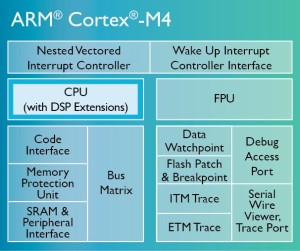ARM has not only revolutionised the embedded processor market in a way Intel could not have imagined 20 years ago.
It is also changing the very different world of digital signal processing (DSP).
Microcontrollers are not designed for real-time processing and so the DSP function has to be added.
Texas Instruments first added DSP elements to its microcontrollers back in 1997. DSP added real-time signal processing which was used in audio and video processing and which has now become a must-have for motor control.
DSP added real-time signal processing which was used in audio and video processing and which has now become a must-have for motor control.
Arguably, the biggest change happened five years ago when ARM entered the digital signal controller market with the Cortex-M4, with its built-in integer DSP, and an optional floating point unit (see block diagram).
Such is the power of the ARM ecosystem, the Cortex-M4 has probably become the de facto standard for basic motor control.
DSP specialist Analog Devices even opted for a Cortex-M4 processor for a motor controller as an alternative to its Blackfin fixed-point DSP.
Analog Devices has now completed the circle by adding an ARM processor to a dual core Sharc floating-point DSP.
It is hoping to use the ARM controller ecosystem, along with the low power dual core DSP to widen the use of floating point DSP in real-time processing applications which currently try to use a system CPU, typically ARM-based processor.
The ARM controller manages the communications interfaces which are crucial in the embedded processor market.
For more detail: What’s ARM doing in the DSP market?
